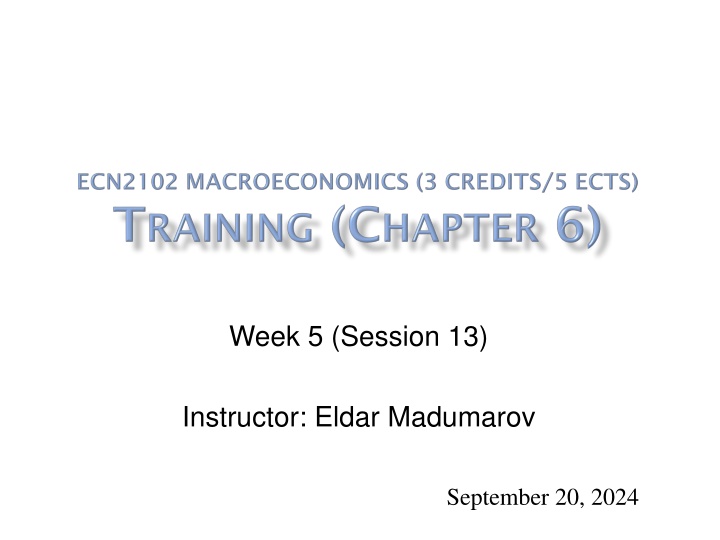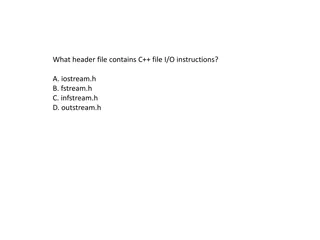
Factors Contributing to Economic Growth in Countries
Explore the fundamental aspects of economic growth, factors influencing long-term growth, human capital development's impact, Solow Growth Model, roles of savings and investment, endogenous growth theories, government policies' influence on growth, and globalization's effects on economic growth rates. Dive into key concepts and theories surrounding economic development and global trade dynamics.
Download Presentation

Please find below an Image/Link to download the presentation.
The content on the website is provided AS IS for your information and personal use only. It may not be sold, licensed, or shared on other websites without obtaining consent from the author. If you encounter any issues during the download, it is possible that the publisher has removed the file from their server.
You are allowed to download the files provided on this website for personal or commercial use, subject to the condition that they are used lawfully. All files are the property of their respective owners.
The content on the website is provided AS IS for your information and personal use only. It may not be sold, licensed, or shared on other websites without obtaining consent from the author.
E N D
Presentation Transcript
Week 5 (Session 13) Instructor: Eldar Madumarov September 20, 2024
Review Questions Training (Chapter 6) 9/20/2024 ECN2102 2
1. Define economic growth. What are the primary factors that contribute to long-term economic growth in a country? 9/20/2024 ECN2102 3
2. How does human capital development contribute to economic growth? 9/20/2024 ECN2102 4
3. What is the Solow Growth Model, and how does it explain differences in economic growth rates across countries? 9/20/2024 ECN2102 5
4. What are the roles of savings and investment in driving economic growth? Can too much saving be harmful for growth in the short term? 9/20/2024 ECN2102 6
5. What are endogenous growth theories, and how do they differ from exogenous growth models like the Solow Model? 9/20/2024 ECN2102 7
6. How can government policies promote or hinder economic growth? Consider fiscal policy, monetary policy, and structural reforms. 9/20/2024 ECN2102 8
7. What is the impact of globalization on economic growth? How do trade liberalization and foreign direct investment (FDI) affect growth in both developed and developing countries? 9/20/2024 ECN2102 9
1) The best definition for economic growth is A) a sustained expansion of consumption goods over a given period. B) a sustained expansion of production possibilities measured as the increase in real GDP over a given period. C) a sustained expansion of production possibilities measured as the increase in nominal GDP over a given period. D) a sustained expansion of production goods over a given period. 9/20/2024 ECN2102 10
2) In 2008, Armenia had a real GDP of $4.21 billion and a population of 2.98 million. In 2009, real GDP was $4.59 billion and population was 2.97 million. What was Armenia s economic growth rate from 2008 to 2009? A) 8.3 percent B) 0.38 percent C) 9.0 percent D) 3.8 percent 9/20/2024 ECN2102 11
3) In 2008, Armenia had a real GDP of approximately $4.21 billion and a population of 2.98 million. In 2009, real GDP was $4.59 billion and population was 2.97 million. From 2008 to 2009, Armenia s standard of living ________. A) decreased B) did not change C) might have increased, decreased, or remained unchanged but more information is needed to determine which. D) increased 9/20/2024 ECN2102 12
4) Using the Rule of 70, if the country of Flowerdoms current growth rate of real GDP per person was 7 percent a year, how long would it take the country s real GDP per person to double? A) 1 year B) 49 years C) 2 years D) 10 years 9/20/2024 ECN2102 13
5) The Rule of 70 is used to A) estimate how much of an economy s growth rate is due to increases in capital per hour of labor B) calculate the economy s growth rate C) calculate the standard of living D) estimate how long it will take the level of any variable to double 9/20/2024 ECN2102 14
6) Real GDP per person in the country of Flip is $10,000, and the growth rate is 10 percent a year. Real GDP per person in the country of Flap is $20,000 and the growth rate is 5 percent a year. When will real GDP per person be greater in Flip than in Flap? A) in 2 years B) in 15 years C) in 10 years D) never 9/20/2024 ECN2102 15
7) As labor increases, there is a A) movement along the aggregate production function and real GDP will increase less with each additional increase in labor. B) movement along the aggregate production function and real GDP will decrease less with each additional increase in labor. C) shift of the aggregate production function, but no movement along it. D) movement along the aggregate production function, but no shift in it. 9/20/2024 ECN2102 16
8) According to the law of diminishing returns, an additional unit of A) labor decreases output. B) capital produces more output than an additional unit of labor. C) labor produces more output than the previous unit. D) labor produces less output than the previous unit. 9/20/2024 ECN2102 17
9) Labor productivity rises A) if firms invest in hiring more workers rather than buying more capital. B) in the absence of technological progress. C) if the amount of capital per worker increases. D) if the amount of capital per worker decreases. 9/20/2024 ECN2102 18
10) Which of the following contributes to an increase in labor productivity? A) increased capital stock B) decreased investment C) increased consumption expenditure D) All of the above contribute to an increase in labor productivity. 9/20/2024 ECN2102 19
9/20/2024 ECN2102 20
11) The first table above gives the labor demand and labor supply schedules for a nation. The second table gives its production function. a) What is the equilibrium real wage rate and the level of employment? b) What is potential GDP? 9/20/2024 ECN2102 21
11) a) The equilibrium real wage rate is $15 an hour because this is the real wage rate for which the quantity of labor demanded equals the quantity supplied. The equilibrium level of employment is 3 billion hours a year. b) With employment equal to 3 billion hours per year, potential GDP is equal to $60 billion. 9/20/2024 ECN2102 22






















